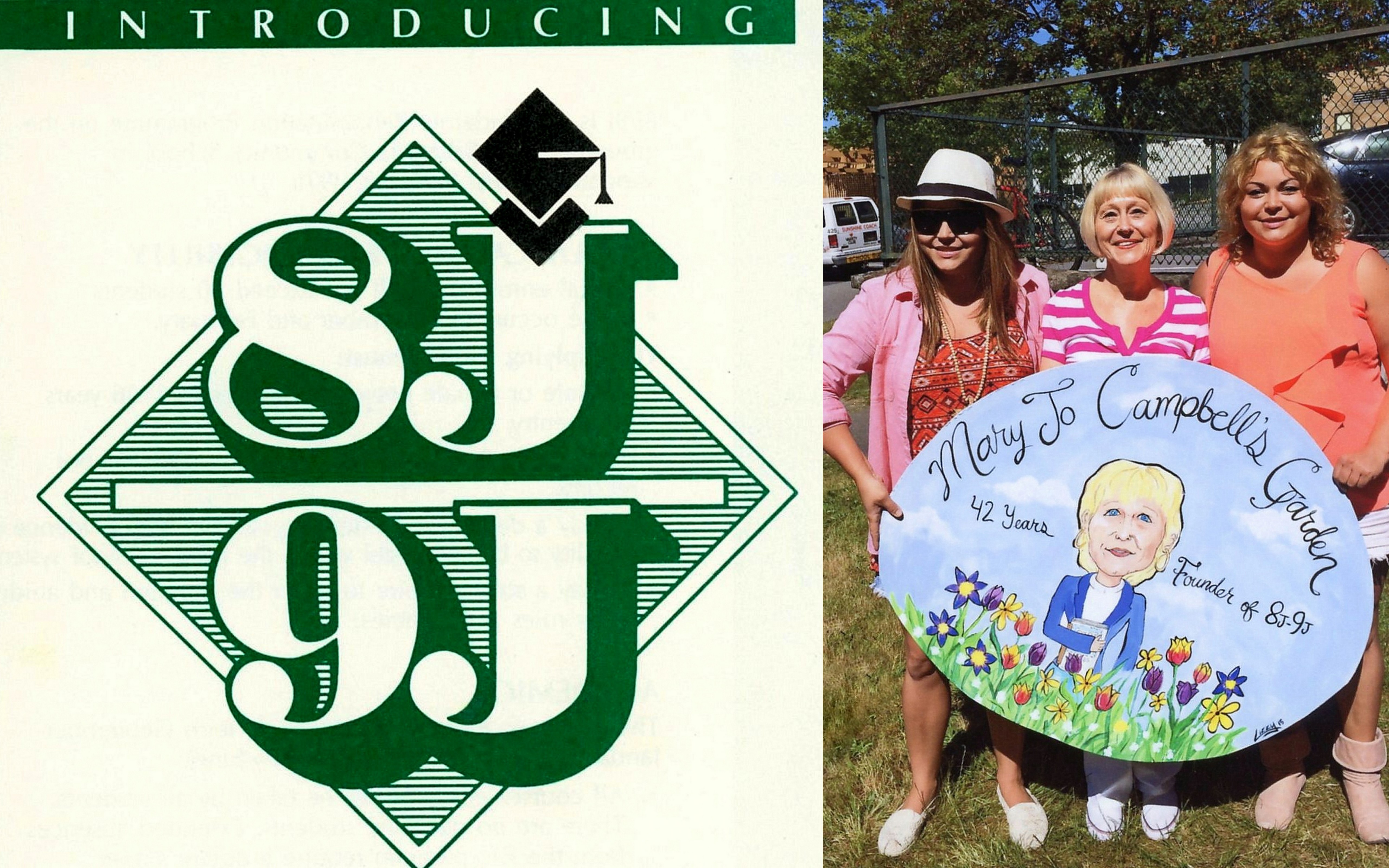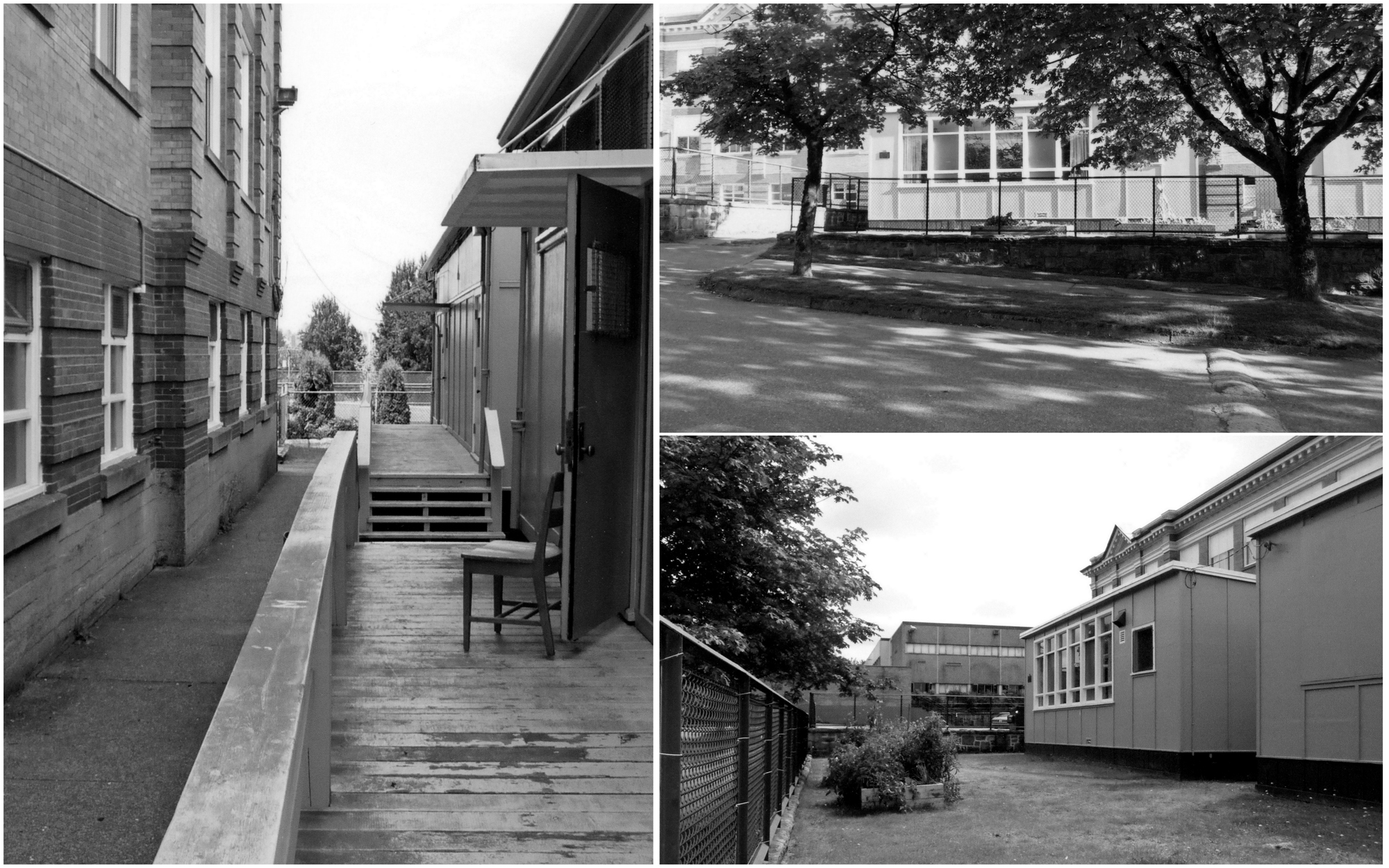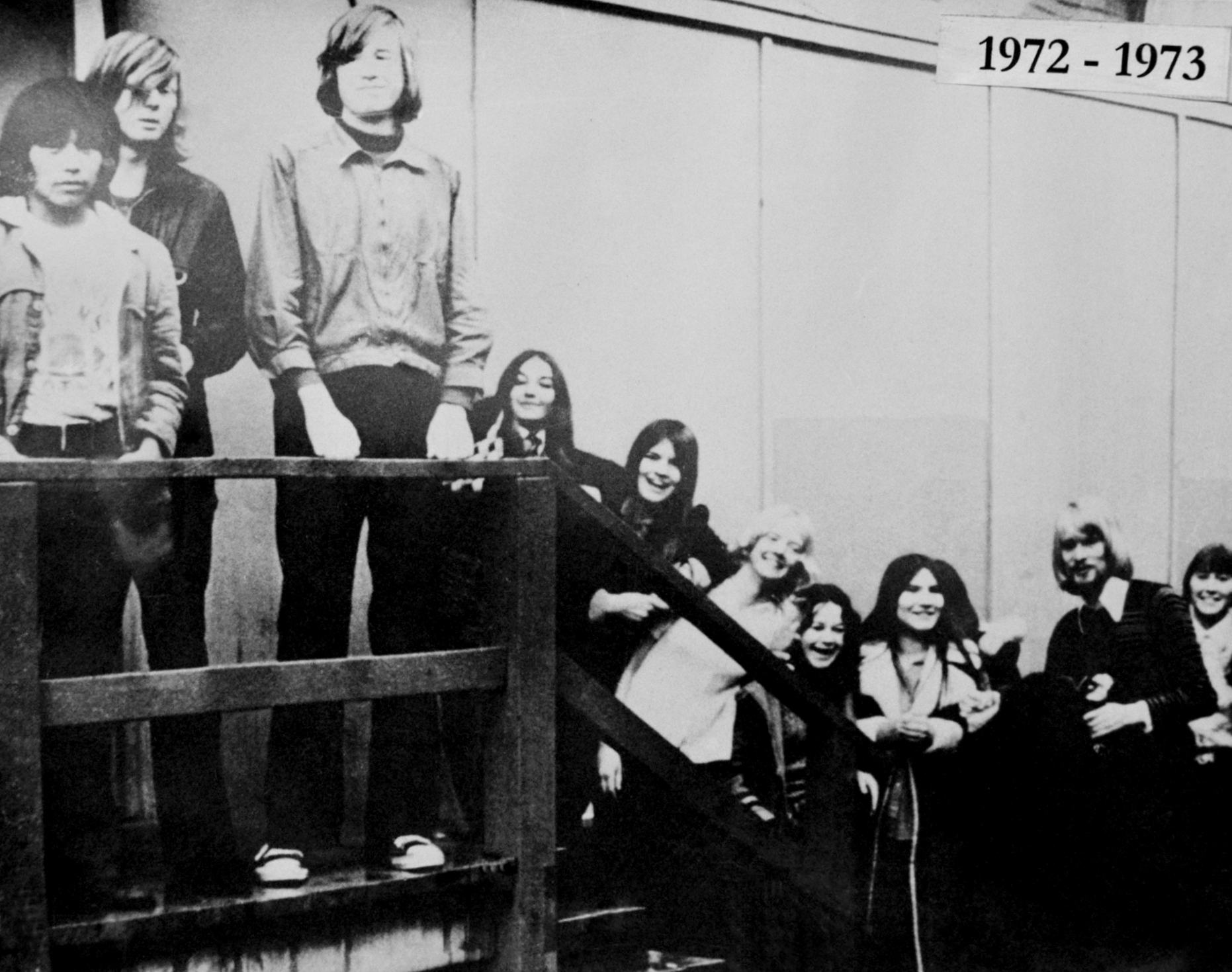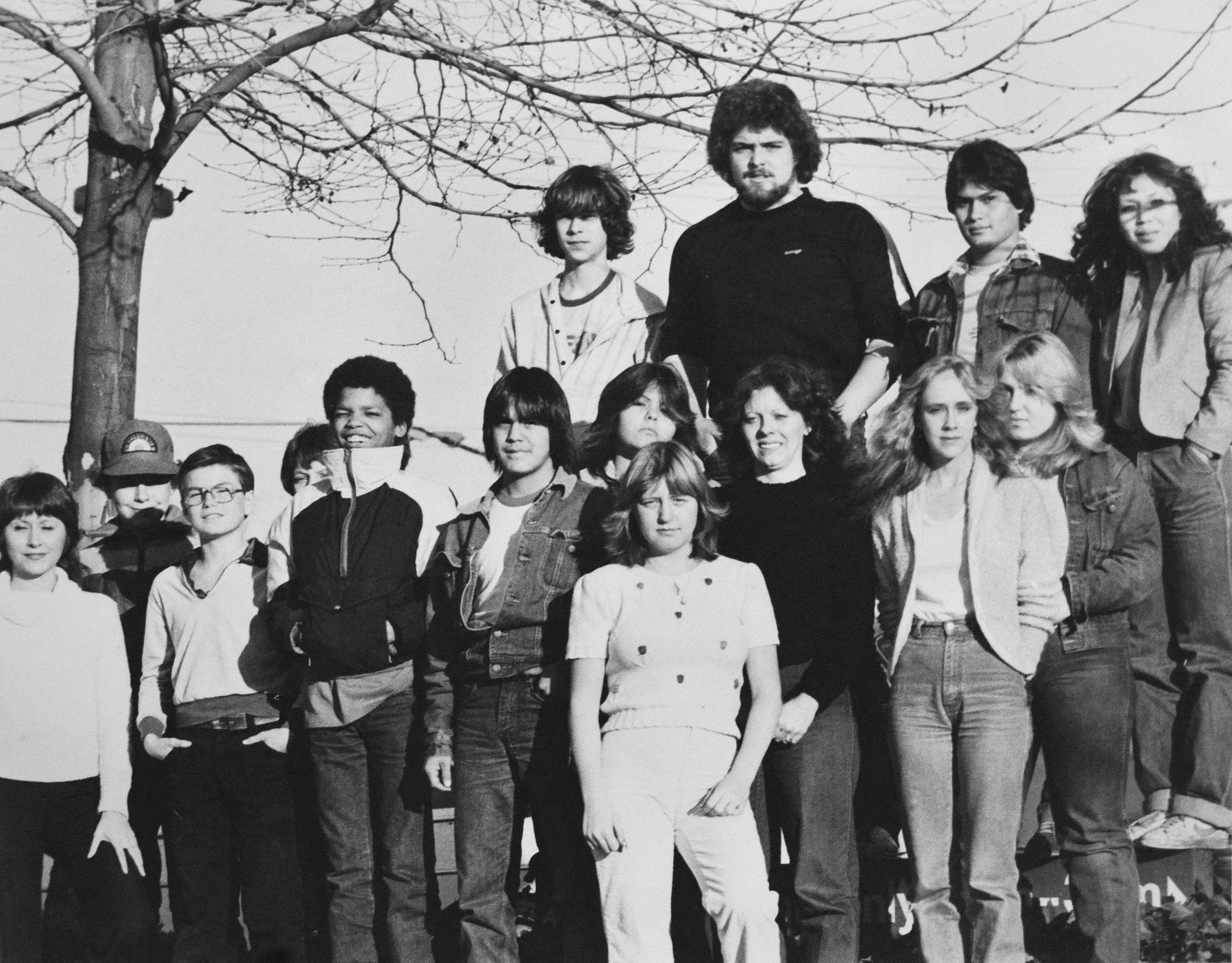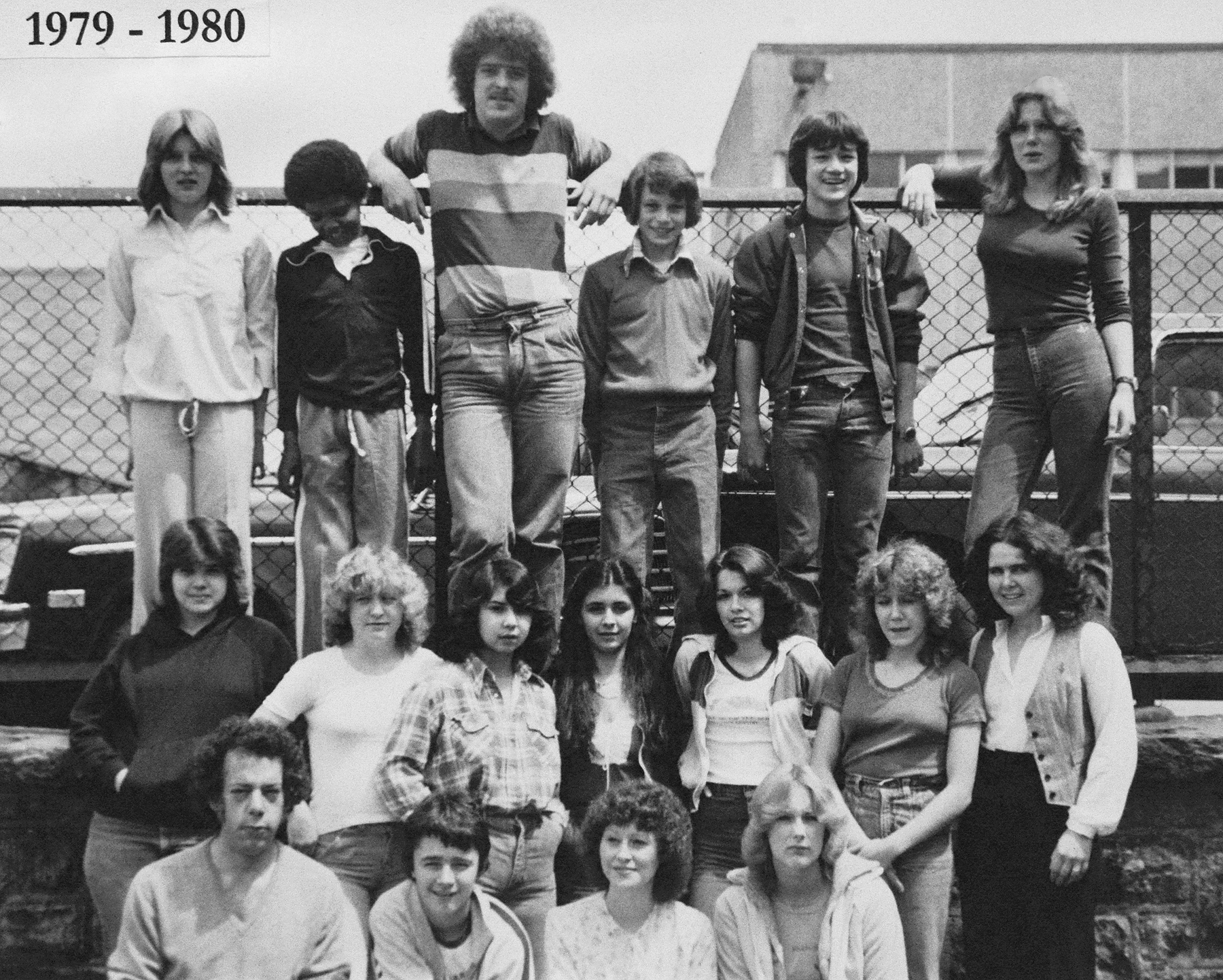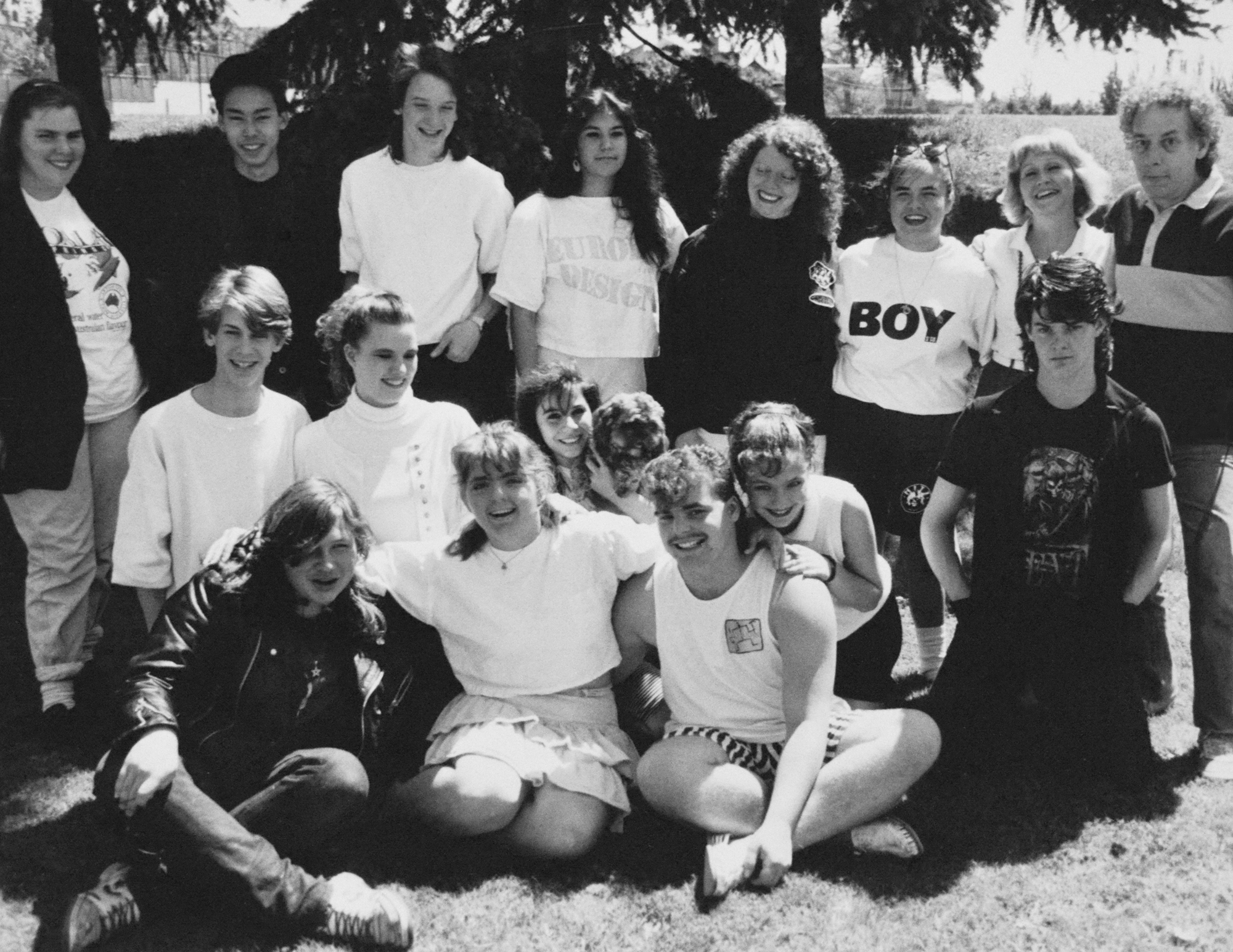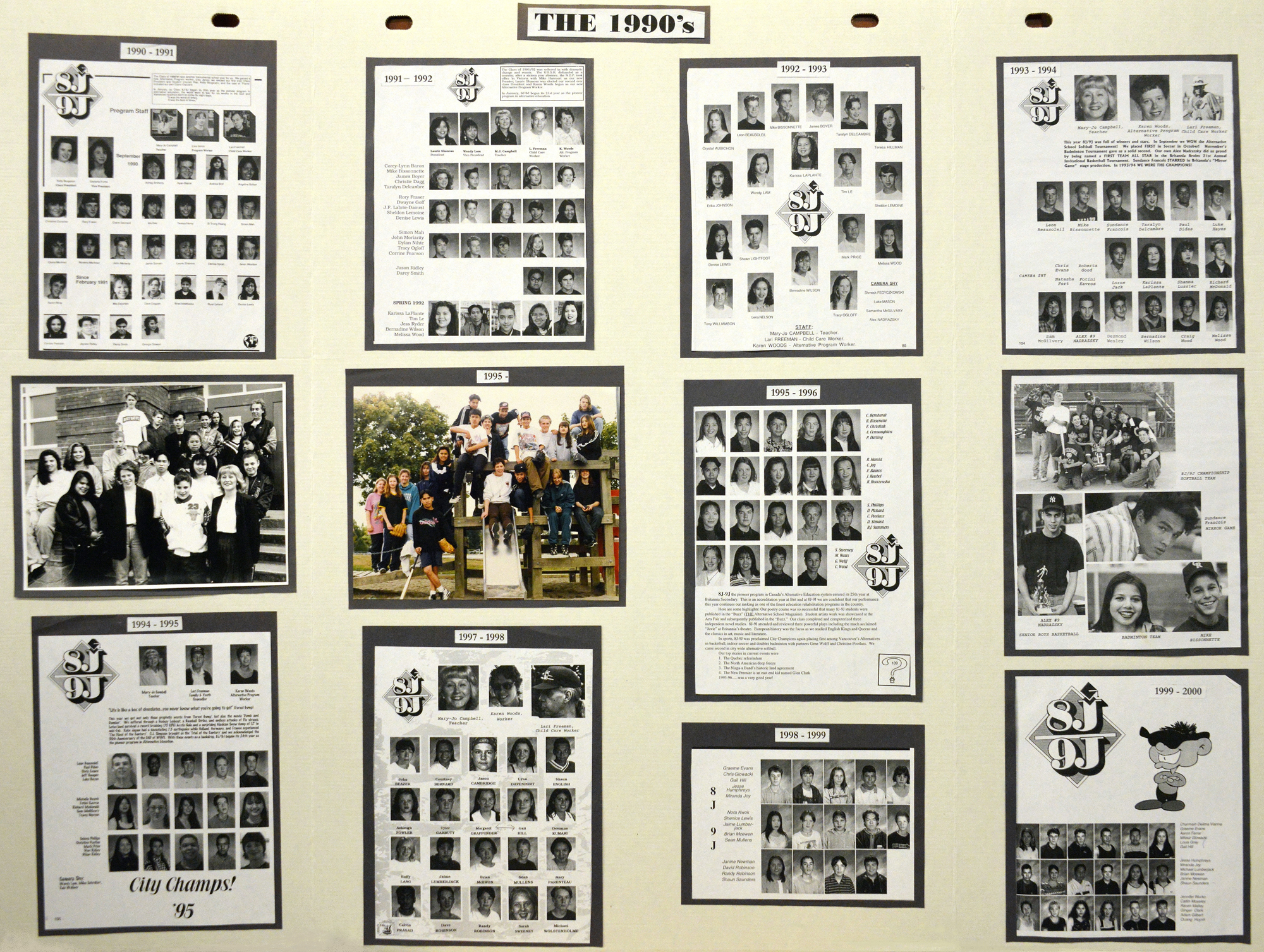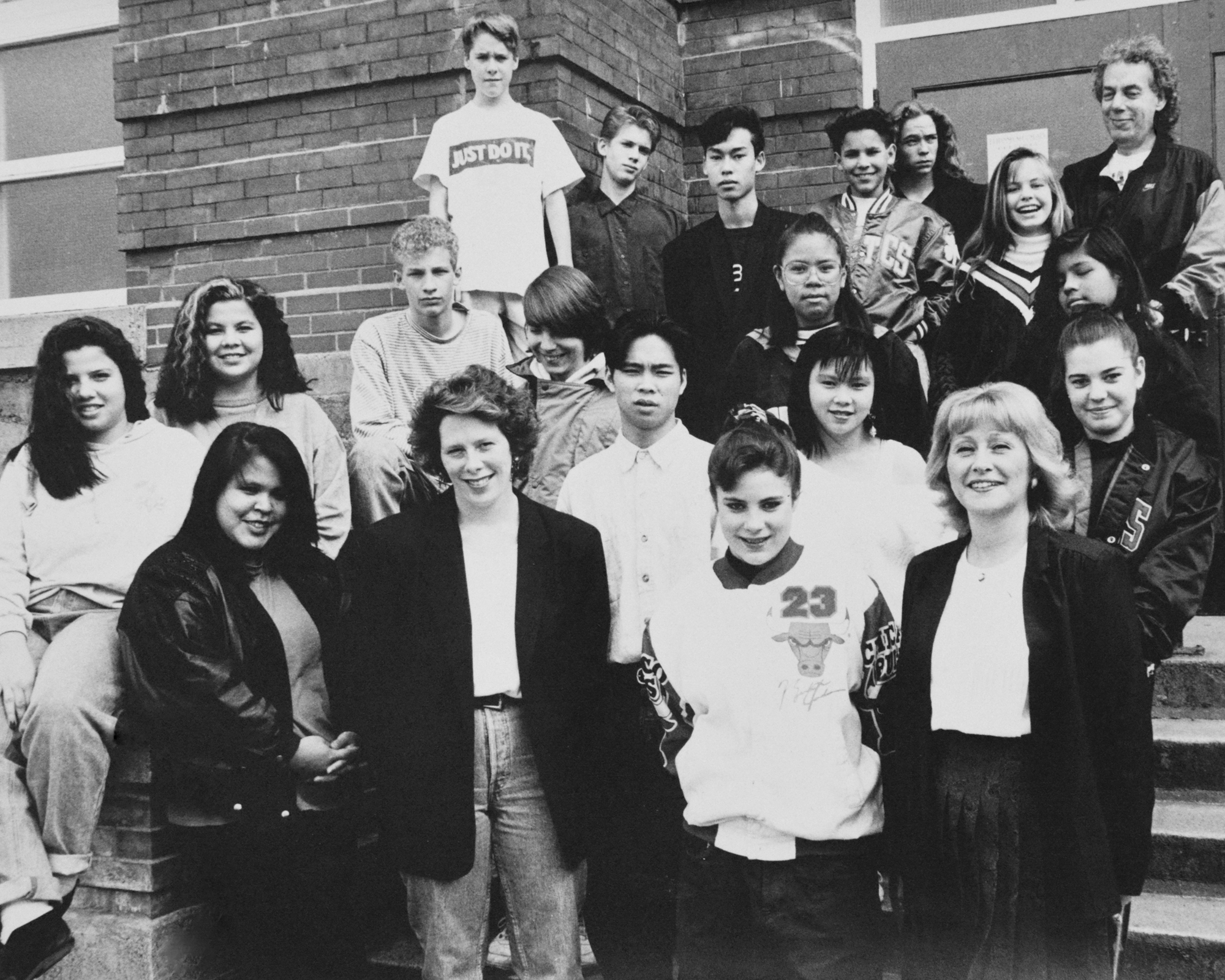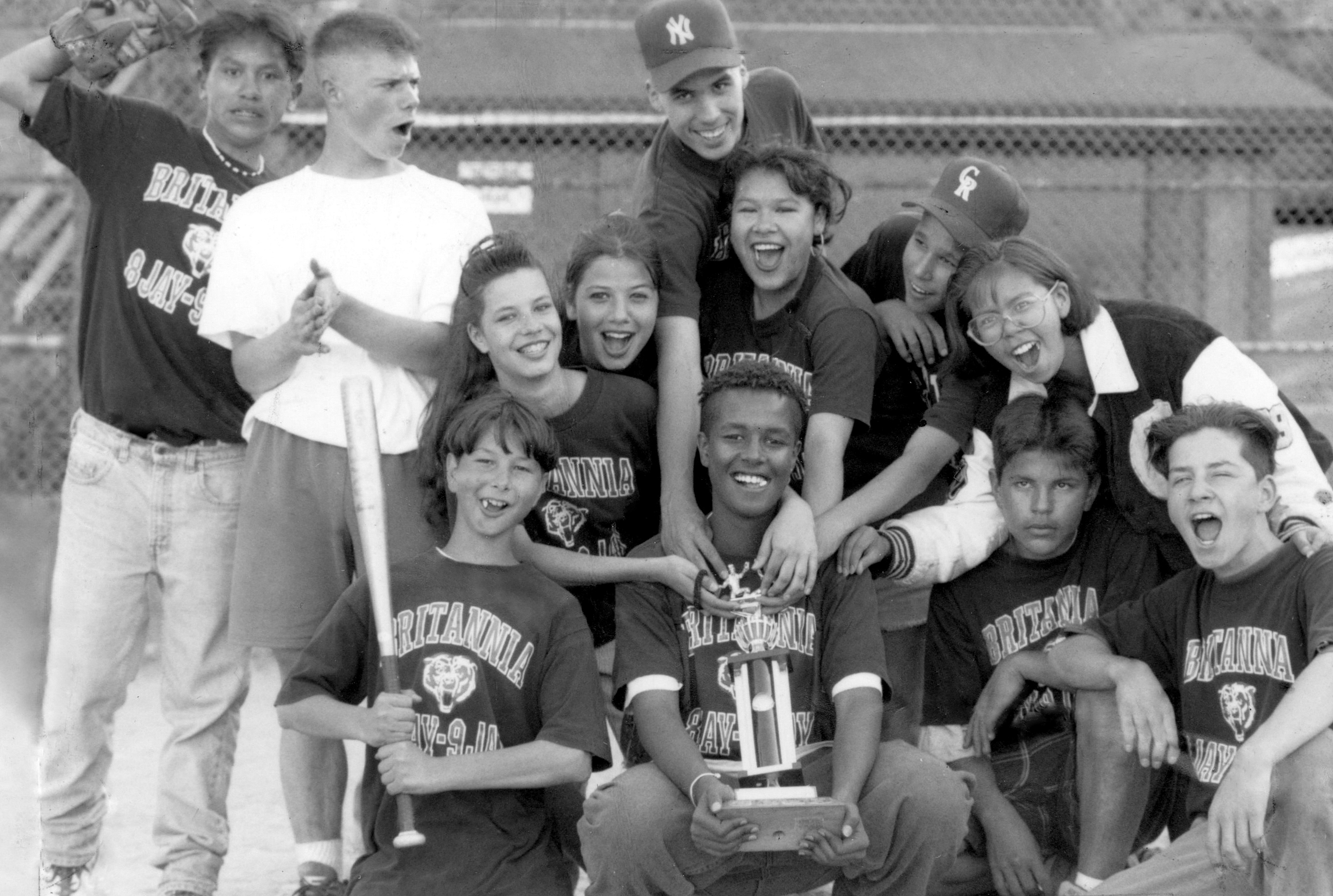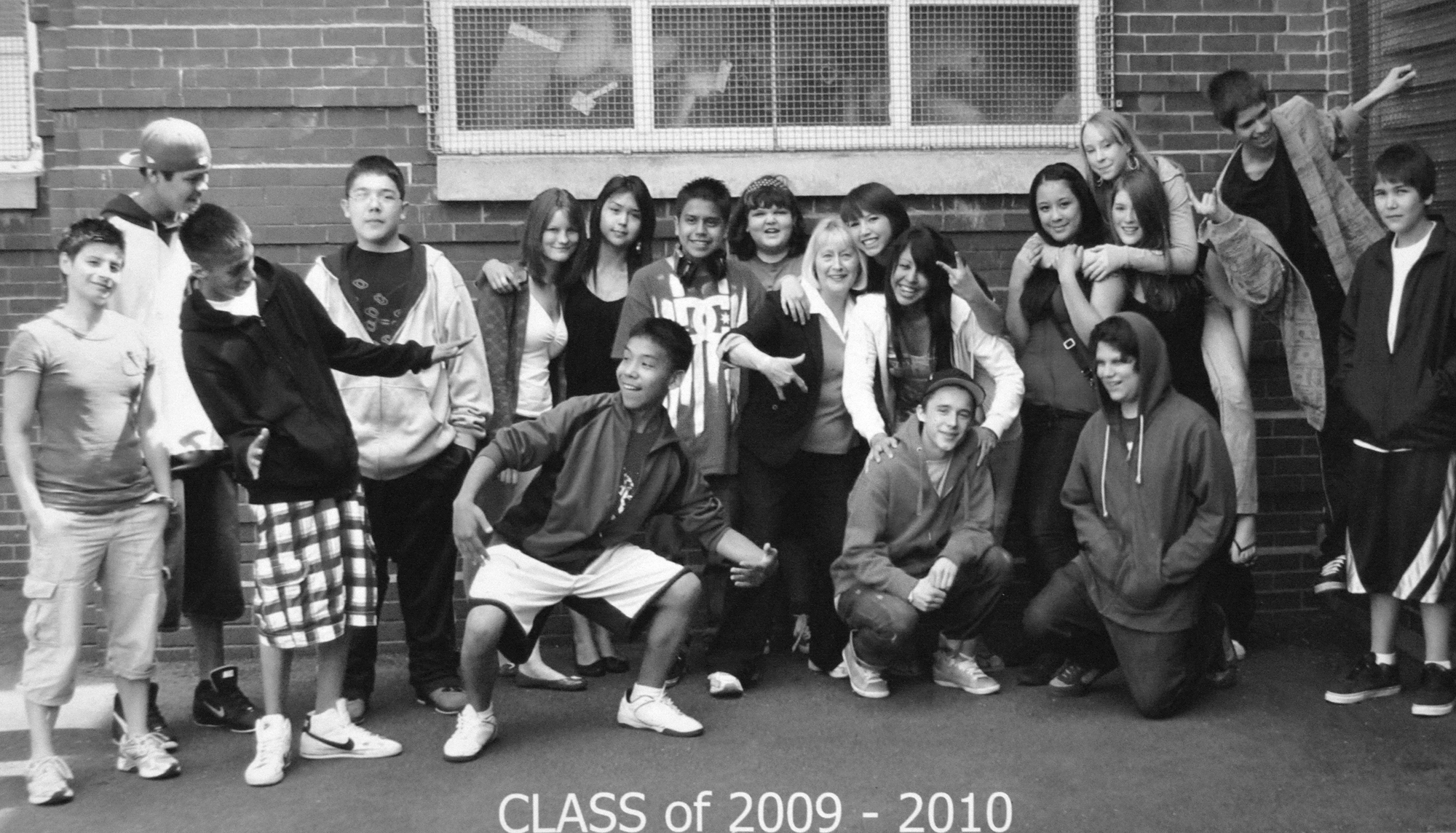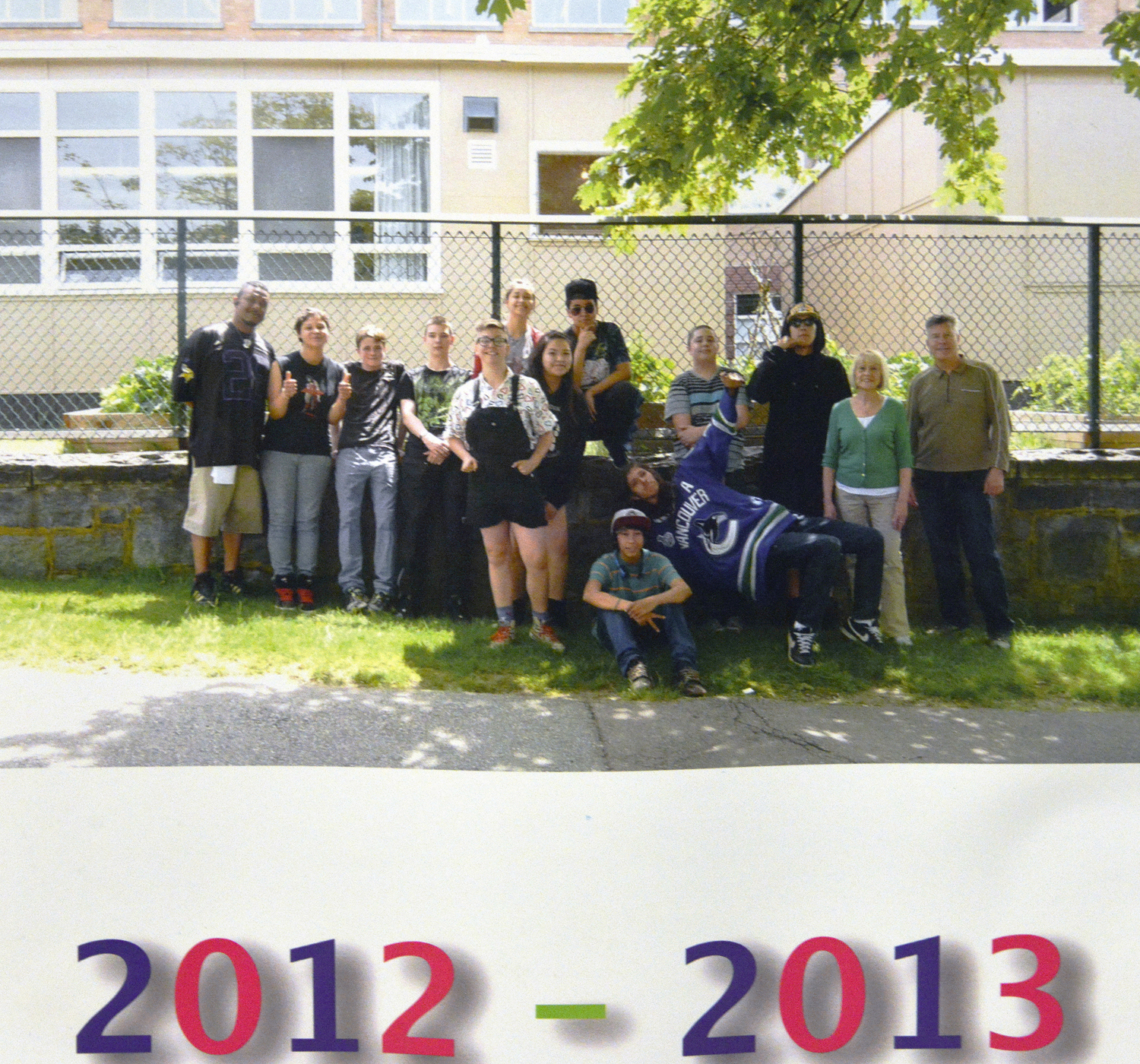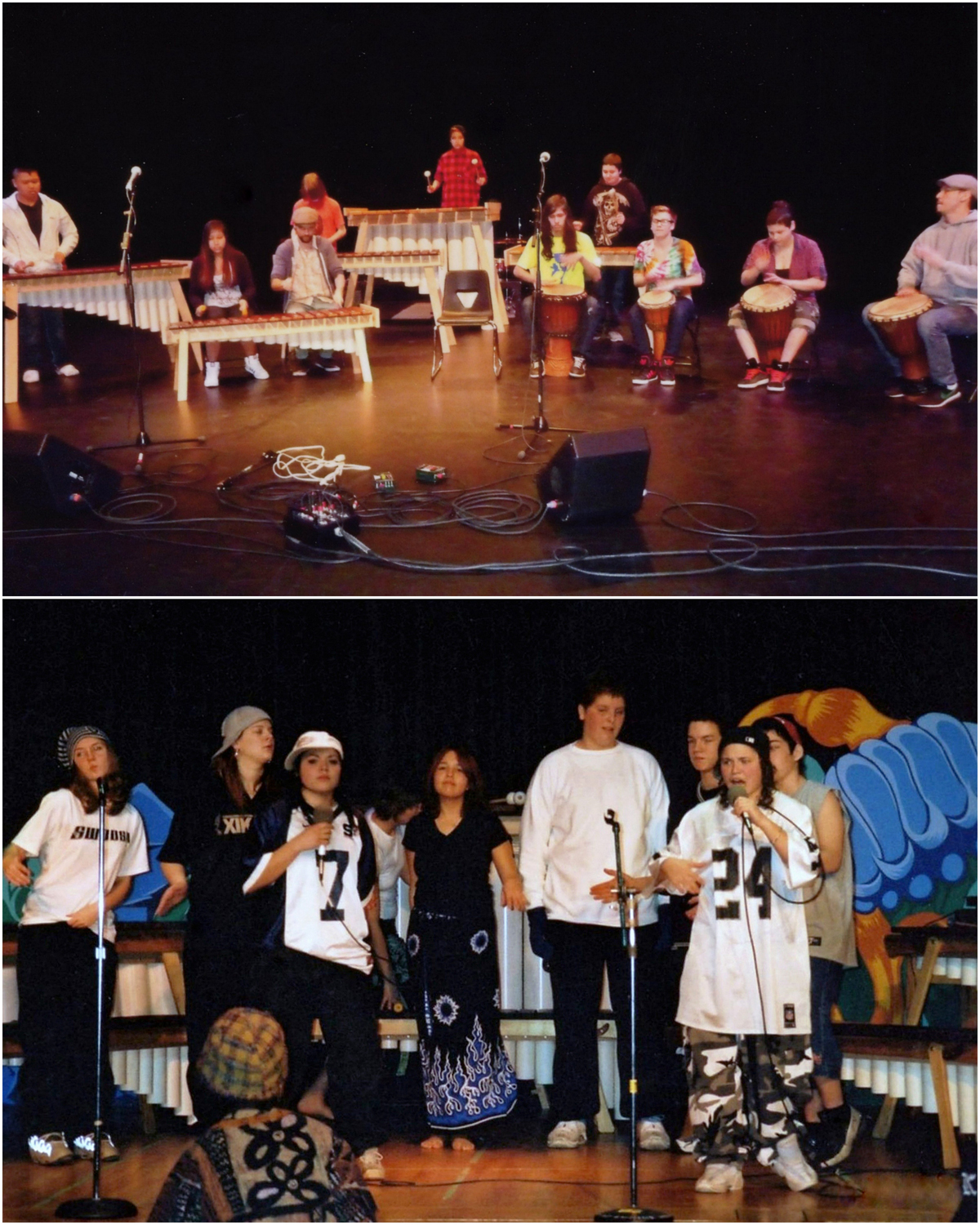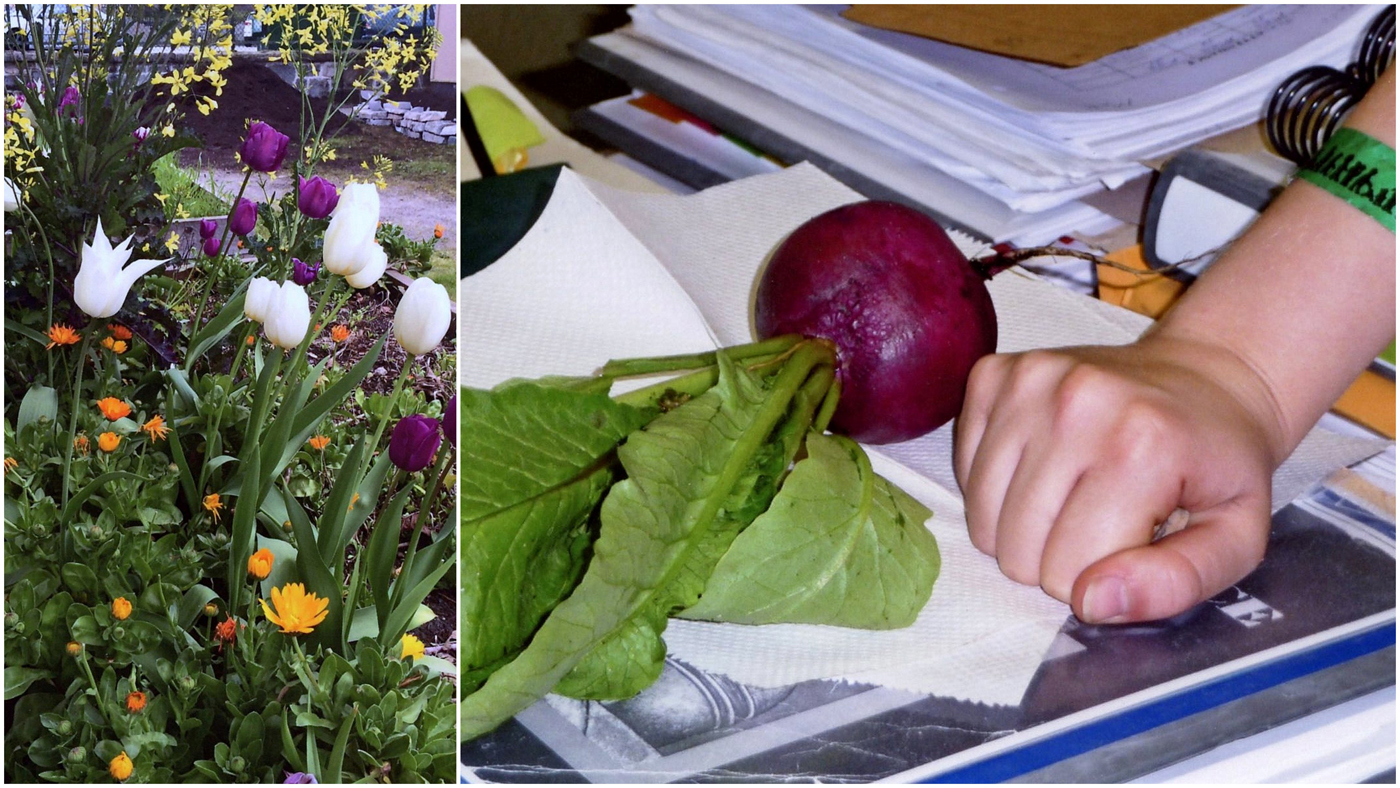Class 8J-9J at Britannia Secondary
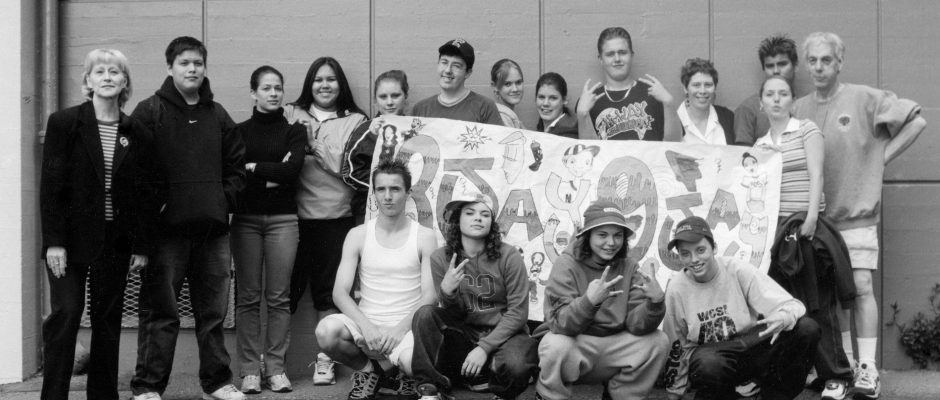
A history written by Mary Jo Campbell, founder of the 8J-9J program.
The Twins, Dani and Lizzy Nelson, Class of 2003, present Mary-Jo with the plaque they created.
This program was originally part of the Vancouver Free University, and operated from a church, on the East Side of Vancouver. That church became the ‘Vancouver East Cultural Centre’ – The Cultch. Four of us, (Mary-Jo Campbell, Ernie Harper, Rod Dunet and Jennie), made application to become one-on-one tutors in Vancouver’s east end under the auspices of the Vancouver Free University For the first year, 1971, the program was funded entirely by the Free University’s government LIP grant, (Local Initiatives Program). We held our math class at the local pool hall and our English classes in various restaurants on the Drive (Commercial Drive). We camped a lot as the program ran all year. We were among the first, the original. We were young and unapologetic. We were idealists. We took risks and we invented ourselves.
Portable Z
In 1972, Britannia, the second high school to be constructed in the city of Vancouver, was the oldest remaining secondary school in the city and had the reputation, as a ‘dangerous east side school. Britannia’s principal, Norval Brown, had asked for our help. He suggested as tutors, we consider working out of a portable unit on the school grounds on a daily basis. He made it apparent that he could supply us with enough clients to justify a classroom. At the end of January 1972, we met with school administrators to prepare for the beginning of the new semester. We moved into portable unit Z on the grounds of Britannia, on the fringe of the school. We called ourselves ‘Project 8J’ because the last grade 8 division in the school was division 8I. Most of our students were between ages 13-16 and in grade 8 in skill level and schooling. Some had been ‘socially promoted’, which meant they were too old to remain in elementary school even though they had not actually completed the elementary grades.
Students were recommended or identified for the program by the Principal of Britannia, Norval Brown and the Area Counsellor, Bill Lum. Probation officers and social workers in the area also presented us with lists of possible candidates. On that first day, we were given a list of our students under the heading ‘Special Tutoring Group’. None were attending school. They were ‘drop outs’ and ‘kicked outs’ – alienated from formal education. They were labeled as marginalised, at risk youth, and they were. But we saw them as bright, reluctant, hostile learners. They were loyal to each other, they had honour. The majority were first nations. Most came from large families (7-9 kids) that existed on either welfare or were low income. The official enrollment for the first semester was 31 students. For the most part, they lived in one of three East side housing projects; Grandview, McCleans and Raymur. Our staff of 4 were still being funded through a Free University LIP grant with Britannia providing the portable unit.
There was no pressure on the kids to show up, initially. Attendance was voluntary. They came only because they wanted to. They were curious, looking for something interesting, positive, something meaningful, someplace to be. Once there, they crossed their names off the Sign -in sheet. This was how we kept attendance. The atmosphere was one of almost total freedom; no locks or rules and we were all on a first name basis. Our students were grade 8s transitioning from elementary to high school. This was a challenging time for most kids, but most certainly for our ‘special tutoring group’. Coming from a small elementary school into a large secondary school taking 8 different courses with 8 different teachers, was daunting. Most had already tried and failed. This transition period was the time when many kids chose to drop out of school and when many were ‘asked to leave’.
Our first year of operation was a major challenge. We were faced with much opposition, harsh criticism and lack of support. Many main school staff were unwelcoming as they thought kids who had been kicked out of school should stay out permanently and not be on Britannia grounds. We made many mistakes, worked incredibly long hours and constantly struggled to come up with an entire new system of schooling. Our ‘school’ had to be informative, interesting and attractive enough to hold our tough audience.
Our Curriculum in the First Months
Our students needed to succeed. We were greatly influenced by the elementary school model as an approach. The kids seemed happy there and had experienced some success with the smaller classes, one teacher, and mostly being in one classroom. The elementary school climate was warm, colourful and welcoming. We set up our portable classroom with the best qualities of the elementary school experience in mind.
Slowly, we introduced a work schedule and a timetable. The daily timetable, in the beginning, had more to do with enticing school drop-outs and ‘delinquents’ to attend the program on a consistent basis than it did with any recognizable academic curriculum. That was to come soon enough. When it did, we scrambled for course material, a grading system, a reporting system and a system of record keeping.
We began with a cooking class. This was our first scheduled hour of class. Miss Louise Smith, the Home Economics teacher at Britannia, had a class consisting of only 2 students in the cooking lab at the time and offered us the remaining kitchen units for our class. This access to the main school facilities and supportive teaching staff proved to be one of the big advantages of having our program on the Britannia grounds and not off site. Our main objective was to get the kids together as a class in the regular school, working together and following instructions (recipes). It was an attempt at having kids start, complete and succeed at something. Cooking class was the largest class we had in terms of the kids attending regularly. We also had access to the wood shop through the interest of Mr. Glen Harvey, the woodshop teacher who gave up his spare period to work with our kids. We held a crafts class in the portable unit and taught candle making, macrame, beadwork and leatherwork. After the Easter Holidays we introduced Art class with painting and drawing.
Academic classes were eventually created to meet the individual interests and needs of each student. The math program used the workbook, ‘Basic Mathematics – a write-in text by Walter C. Brown. The kids called it ‘The Red Book’. Each student worked at his own speed to complete the work. We also created and introduced a ‘Money Games’ course to familiarize the kids with ‘real life’, including budgets, banking procedures, bill paying and the cost of living. They were taught such tasks as balancing a chequebook, and calculating percentage and interest. Each student selected a job from the classified ads in the newspapers and negotiated salary and benefits with the instructor. A major bank in the neighbourhood supplied us with books of cheques and cheque registers. Pay cheques were distributed by the instructor and students used their cheques to pay rent and make purchases. Students were responsible for creating their personal budgets for food, clothing, rent, and other expenses. It was a very successful approach to teaching math and life skills. There was high student interest in this subject.
The Science curriculum was suggested by our students who chose to learn about growing plants, and anatomy and physiology. They wanted to know about their bodies as they were maturing and changing and had many questions about what was happening to them.
Social Studies had students working in groups on projects that interested them. One group worked on a Gastown Project that included map making, research, picture taking, people watching, field trips and written reports. Another group project involved kids examining their own housing project from many perspectives including conducting surveys, interviewing residents, taking pictures, and completing written reports. A group of 5 girls completed a mini-project on Group Homes in Vancouver. We all had gone on a field trip to explore Vancouver and we were surprised to learn that most of our students had not been anywhere outside the limits of the East Side of the city. When we toured Shaughnessy with its big, beautiful homes, the kids thought they were “the nicest ‘Group Homes’ they had ever seen”.
There was so much to admire in these diverse young people, despite their troubled lives and alienation from formal education. You had to appreciate their fierce protection of their neighbourhoods, their loyalty to each other and their obvious intelligence. In reflecting on their potential, there had to be a way to turn these kids back on to school.
8J was primarily instituted as an experimental pilot project with the goal of reintegrating grade 8 drop outs back into the school system. We were succeeding. Attendance was great and we were achieving our goals. The principal was pleased with our efforts as were the students, their families and the community. After only 5 months of operation, the L.I.P. grant was due to expire. One of the teaching staff left the program by April and by June 2 more teachers left feeling completely overwhelmed and incredibly underpaid. Only one teacher remained, Mary-Jo Campbell. Our first program evaluation was written in the form of a request to have the grant extended until September. Each of the students wrote a letter of support for the program and The Vancouver Free University submitted their proposal for renewal of the L.I.P. grant. There was no grant, no salary, for that final month.
Summer 1972
Funding was provided by an L.I.P. grant through the Free University once again. Another staff member, Calvin Lee, joined the team and together we took fifteen of our students to the Okanagan Valley for two weeks. This was the beginning of establishing credibility for ourselves and for our program, among the students. We stayed in a cabin in Summerland on the shores of Lake Okanagan where the kids swan and built rafts. We road horses up to the top of Giant’s Head Mountain, fished in Trout Creek and visited the Game Farm. It was perfect.
Summer 1972 was special! Being so far away from the portable and Vancouver East, we were able to just ‘be’ with the kids. Lying on the beach one night, we asked what they would like to study and learn in school. Away from the big city lights on a clear night, the kids were introduced to a spectacular, constellation filled night sky. This sparked an excitement about astronomy which evolved into a science unit that remained a favourite in the program right up to the end. After that, the student’s passions and direction continued to be both solicited and welcome in the curriculum.
This wonderful summer, resulted in ‘summer camp’ being a regular part of the program, at least for a few more years.
In September 1972, grade 9 studies became part of the curriculum and we became Class 8J-9J. Two staff members were now employed by the Federal L.I.P and an operating budget from the City Social Planning Department was in place. The Vancouver Free University provided us with the use of a van and our facilities, Portable Z, was still provided courtesy of the Vancouver School Board. Our student enrollment was set at 20 students and academics became 50% of the program content.
In January we held, in our home, our first ever graduation ceremony. Five of our first students graduated from grade nine. Four of them enrolled in regular grade10 classes in Britannia right away as Britannia was operating on the semester system. One of our first grads immediately joined the work force. All of them said they wished 8J-9J included grade 10.
Our second summer camping trip was to Cultus Lake. The two of us took eighteen of our students there in the summer of 1973.
September 1973-June 1974
In September 1973, the program was given temporary status as a public school alternative. The teacher was now on salary with the Vancouver School Board and an operating budget of $1500 was provided. The Department of Human Resources provided a salary for the Child Care Worker and an operating budget of $1500 as well.
The program had matured over the past year and a half from being an academic drop-in centre to a fully credited Grade 8 and grade 9 school program.
Students began applying for a seat in the class, mostly through word of mouth and through recommendations by counsellors. We even had a waiting list.
We shared a Van with the new ‘Outreach School’. Britannia was also their ‘Mother school’ but they were located off site in a space in the First United Church at Hastings and Gore. It was their van.
The new ‘Streetfront’ program also opened off site in a storefront not far from Britannia on Commercial and Venables. Britannia was now the ‘Mother school’ for three alternative programs, one on site and two off site.
A new experimental approach had been implemented in 8J-9J, a segregated classroom. Ten girls studied with the female teacher and ten boys studied with the male child care worker but this proved to be a big error in strategy.
Summer of 1974:
The child care worker had left the program in June and was replaced by Lari Freeman, who would remain with the program for the next 35 years. We took five of our girls camping and touring Vancouver Island for two weeks. Our third summer camp was the trip of a lifetime for them. We toured the Parliament Buildings, The Provincial Museum and had High Tea at the Empress. The girls visited Her Majesty’s Suite and the Prime Minister’s Suite. We ended our magnificent tour with visits to the Royal London Wax Museum, Craighdarroch Castle, the Butchart Gardens, the Undersea Gardens and finally, the Unique Glass Castle. We made a scrap book of our adventure when we returned and it was viewed with envy by hundreds of 8J-9J students for the decades to come. It inspired future fund raisers like car washes and bottle drives, when our operating budgets began to dwindle.
Community School (K-12)
September 1974-June 1975, was a most important year for Britannia and for 8J-9J. Britannia Elementary opened its doors on January 9, 1975 and Britannia Secondary became Britannia Elementary Secondary School. This was also the year of the incorporation of the Britannia Community Services Center Society and the year that Britannia became a Community school. 8J-9J was part of it all.
In September1974, the grade 10 curriculum was added. 8J-9J had finally evolved to become a three -year program for grades 8, 9, 10 and academics became 75% of the curriculum.
The General Knowledge program was implemented. This social studies course was unique and remained one of the major features of the program. It was a cultural studies class created by the teacher and was presented in ‘quiz game’ style. Originally it operated on a weekly cycle. Each Monday, the students were given 50 questions to research concerning such categories as famous people, famous art works, important historical evets, acronyms and initials, famous music compositions and classic literature. During the week the students would work individually or in groups to answer the questions.
The answers would be found in classroom reference books, (class sets of Dictionary of Proper Names, Dictionary of Biography), in the subjects being studied, in the music being played on the sound system, or in the many displays of art and information posted in the classroom. At the end of the week, a test was given on the 50 questions to determine how much ‘General Knowledge ’was acquired over the week. In this manner, the students in 8J-9J learned significant amounts of useful and general knowledge information including the names of government officials and political ‘hot topics’. Such information was previously of no interest to our students.
The students really enjoyed this course and were rather surprized a few years later when, in 1979, the board game ‘Trivial Pursuit’ was on the market. It was almost identical to our General Knowledge program. It was described as a board game “in which winning is determined by a player’s ability to answer ‘General Knowledge’ questions”.
This year,the E.R.I.B.C. conducted on extensive external evaluation of Class 8J-9J as one of the nine original Vancouver Alternative Programs. It concluded that 8J-9J had at least five major areas of strength related to the success of the program;
- serving a rehabilitative function
- having a well developed and highly organized set of instructional procedures
- having a dedicated and caring staff
- able to effect positive attitudes on the part of the students, parents and community towards the program;
- having excellent relations with other educational institutions
Summer 1975, we went back to Trout Creek with eight kids for our fourth summer camp.
Portable East
September 1975-March 1976
This Was the year the teacher, Mary-Jo Campbell, was finally given permanent status. We maintained our child care worker position as well and added a new position to the team, staff assistant, (Gail McAsey). It was only a temporary position at this time however.
In September 1975, we moved from portable Z into Portable East, a new portable on the opposite side of the school from where we were. It felt more inclusive. We were closer to Britannia’s new wing and we could be clearly seen from ‘The Office’. We were no longer on the ‘fringe’ of the school grounds. A wall of windows, allowed us a beautiful view of the North Shore mountains and there was space for our own office.
Eventually, over the next two years, lockers and desks were brought in. We slowly introduced desks into the classroom as awards for attendance. Only the best attenders got a desk everyone else sat at the tables. It became a sense of pride to have your own desk; it was property ownership and the students were allowed to decorate their desks and lockers. This helped to alleviate vandalism. Many of these decorated pieces of ‘real estate’ were works of art. By September 1977, every student had a desk and eventually we introduced ‘the seating plan’. The best attenders got to choose where they wanted their desk to be and most wanted to be right up front so they could see the board and hear what was being said.
Finally, there was only one big table left in the classroom. ‘The Table’ was situated at the back of the classroom and remained in the class till the very end. It was the ‘lunch table’, the ‘games table’ (for chess and Risk tournaments) the interview table and the table where everyone, through the years, carved their name or left a written message to say “I was here”.
We very happily remained here, in Potable East, until the end in June 2016.
This was also the year of our first inter-school tournament, a soft-ball match with the new Outreach program.
A very special guest visited our classroom; former Britannia graduate and Premier of the Province of B.C., Dave Barrett.
Two new awards were added at this year’s Awards Day Ceremony:
- Most Improved Student
- Literary Award
The B.C. Youth Development Centre began Norwicki-Strickland Locus of Control testing on 8J-9J students and an extensive internal evaluation was submitted to the funding bodies.
Since January 1972, we had serviced 79 students and employed 7 staff members. We developed the original ‘academic drop-in centre’ into a well defined ‘Re-entry and Rehabilitation Program’. The Program began as a re-entry point for grade 8 students only and expanded to include grade 9 and grade 10. We experimented with a greater degree of success than of failure. We developed and designed special courses able to be included in any school curriculum.
The analysis of our observations and assessments for our April /76 evaluation after only four and a half years, told about the achievements and shortcoming of Class 8J-9J. Our ‘Three Steps to Basic Acceptance’, namely, upgrading basic skills, rehabilitation and re-entry, proved to be steps in the right direction and our methods of achieving those objectives were in order. All persons involved in the program, Staff, students, parents or agency involved, expressed satisfaction with the goals and the results. We noted that:
“one’s achievements constantly generate new tasks
The A.C.T. Report, May 1976, described 8J-9J as an Alternative Rehabilitation Program with 1 Teacher, 1 Staff Assistant and 1 Child Care Worker. There were 27 students in the class ranging from13-18 years old. The average attendance was 80%. The report was supportive and recommended that the Program be continued, that enrollment be limited to 20 students and that funding be provided to support an active arts program and a summer program
The 8J-9J Philosophy:
“All excellent things are as difficult as they are rare.” – Spinoza
The decision to teach is a moral decision and one must first examine completely their personal philosophy. The difficult part comes when you endeavour to maintain your moral principals through trials and tribulations. This is the road to excellence. The philosophy that nurtures the 8J-9J program comprises realized concepts.
- The Self-Fulfilling Prophecy
These students possess qualities that seem to go unrecognized as being worthy of recognition. Courage, humour, spontaneity, independence, individuality and vulnerability. The staff endeavours to consistently acknowledge and reinforce the worth and uniqueness of each student.
- “Romance must precede precision.” – Whitehead
We believe everyone has a desire to learn and to know. The problem has been with our students it seems, a problem with procedure. The role of the teacher is that of translator-transmitter. Information must be translated into terms that can be understood before it can be transmitted. The romantic part is becoming that aware and caring that much about each student to consciously, and not by chance, communicate a concept to them.
- The Importance of Individuality
The complexities and uniqueness of our students are attributes to be expanded, not compromised. We value individualism.
- The Concept of Choice
We believe a person is free when he is free to choose. Knowledge allows this to happen. A realization that you have a choice, indicates a certain amount of power or control. (Locus of control) Those who possess this feeling have been found to be socially and academically more successful.
- Maintaining an Overview
The idea of developing one’s character or obtaining an education should be a long term project that exercises the qualities of patience, tolerance and endurance. We should not be as active in seeking more expedient ways of teaching our children but rather actively seeking more humane and individual approaches.
“There is more to life than increasing its speed.” – Gandhi
Our Goals were to:
- upgrade basic skills
- provide for social development
- encourage re-entry to regular school
- promote self-esteem and self-worth
- communicate the ‘Joy of Learning’
Evidence of Attitude Change:
The A.C.T. report gave evidence of a positive attitude change among our students quoting a questionnaire standardized by Nowicki and Strickland. The questionnaire was administered by Robert F. Wilson, PhD, in September 1975 and again in February 1976. It showed there was a significant move among our students from a belief in external control to a belief in internal control. Belief in internal control has been demonstrated to correlated very highly with academic success, high self-esteem, and good adjustment.
Evidence of Educational Growth:
The Gates-MacGinitie Reading Test administered November, 1975 and March, 1976 showed the following increases:
- Speed and accuracy – the class median rose from 8.6 to 10.5
- Vocabulary – the class median rose from 6.2 to 8.4
- Comprehension – the class median rose from 7.4 to 8.4
Norval Brown, Principal of Britannia and mentor of the 8J-9J program, retired in June.
September 1976 – June 1977
We introduced a new Staff Assistant, Mary Beth Sullivan. Mary Beth remained the Alternative Program Worker (APW) at 8J-9J for 14 years before becoming a Youth and Family Worker (YFW) at Total Education for19 years. She returned to Britannia in 2009 as YFW at Outreach. She also served as President of The Vancouver Alternative School Association. Mary Beth retired in 2017 after 40 years of service to students and communities in Vancouver.
The first day back in September 1976, we, the staff, all wore “Welcome Back’ t-shirts and played the Welcome Back Kotter theme on our new sound system. Welcome Back Kotter was a popular TV sitcom at the time. Our Partner in Education was a DJ from radio station CKLG, Michael Morgan, who supplied us with the shirts and large gift bags to distribute to our students to welcome them back.
This year Art Class became serious. We had an actual art teacher (Bob Chambers) working with the kids. He introduced them to mediums like oil on canvas, stained glass, and wire sculpture.
The first ever Alternative School Sports Day was also this year. It was held at Stanley park and was more like a picnic. The events included 3-legged races, relay races, the doughnut- eating- contest and the one mile bicycle race.
One new award was added to the Awards Day list:
- The Service Award
- We had four graduates this year
In May 1977 our three staff members submitted an Evaluation up-date. We had already completed two very extensive reports by this time. One was conducted in 1975 under the direction of the Educational Research Institute of British Columbia (E.R.I.B.C.) and the second was a comprehensive internal evaluation prepared by The Administrative Coordinating Team on Alternative Education (A.C.T.) and submitted to the various interest groups in April, 1976.
In the May 1977 Evaluation, we described our facilities as:
“[. . .] adequate in that we make use of the materials in Britannia, (A.B. Dick, ditto, Xerox and Copytron machines, book room and receiving room and audio-visual equipment). Although many would disagree, we find the advantages of being located on the school grounds far out way any disadvantages. We are most happy here.”
Robert F. Wilson reported on his results of the evaluations of attitudes as measured by the Nowicki-Strickland Locus of Control scale.
“The results of this year’s study of 8J-9J students shows that the significant change in attitude noted last year has been maintained. In addition, the data show that the students continued to improve their beliefs about their control over their lives the longer they attended 8J-9J. Thirteen of the original twenty-one students have now left the program. Eleven of the thirteen are either enrolled in regular school or are successfully employed in the community. This data corroborates the locus of control data, and strongly indicates that both attitude and behaviour have significantly improved among the students attending 8J-9J.”
Our first decade ended with 8J-9J finally being included in the Britannia Year Book (1978). On November 23, 1979, BCTC News Hour visited the class to film our story and it was on the air later in the week. They would return to 8J-9J many times over the years to come to continue telling our story. In the Spring semester of 1979, the teacher sponsored the program’s first student teacher, Steve Bath (from UBC’s Community Education Program). Under Steve’s direction, the class made a movie titled ‘High School’ using Pink Floyd’s ‘The Wall’ as the soundtrack. He included all the students in the class in this production as he cast Punk Rockers and rowdies, make-up artists, playwright, script director and support cast. This project was a big success. He did such an amazing job. Everyone was sad when it was Steve’s last day. Eventually, (a little more than two decades later), we introduced film making as part of our curriculum
In May, 1980, another evaluation of 8J-9J was completed and included with Britannia’s Accreditation process.
It described the staff members at Britannia as having offered us much assistance and support over the years. Brit teachers involved with 8J-9J graduates made regular contact with the program staff and prior to graduation, the students were advised of the available alternatives for continuing their education. Appointments with counsellors were arranged. The most popular choice for integration at this time was the various programs offered by Vancouver Community College.
Of the 38 graduates from 8J-9J we had by the end of 1979:
- 27 had enrolled in various public schools.
10 of those had graduated from grade 12 by 1979 and
1 had enrolled at *S.F.U.
6 were still enrolled in various public schools.
- 8 had successfully joined the workforce
- 3 had yet to find employment
*Our first ever University graduate was Esther Rausenberg who was enrolled in 8J-9J from November 22, 1972 to September 1974. She graduated from grade 10 and enrolled in Britannia main school and graduated grade 12. She received her Bachelor of Arts Degree (B.A.) in Communications from Simon Fraser University, and her Master of Arts (M.A.) in Asian Policy Studies from The University of British Columbia in 2004. She also earned a McRae Institute of International Management, International Business/Trade/Commerce from Capilano University. She is the Executive Director of the Eastside Culture Crawl Society since March 2013 and the Founding Director & Co-artistic Director of Creative Cultural Collaborations Society.
By the end of the decade, the Britannia facilities available to Class 8J-9J had grown to include the school library, ice rink, pool, gymnasiums, woodwork shop, graphic arts studio and playing fields. The location, facilities and equipment gave our program a great deal of credibility in the eyes of our students. They saw themselves as belonging to a class in a regular school, travelling in the same direction as other students in the area and sharing a common school spirit. We once again reiterated that although many alternative programs disagreed, the advantages of being located on the grounds of the mother school far outweighed any disadvantages.
Eventually, we drew in students from all over the city. Over time, family members enrolled in the program, including brothers, sisters, cousins, aunts, uncles and eventually, the children of many of them. We became an extended family.
Our first decade came to a successful end.
PHOTO ALBUM: 1972 – 2013
8J-9J and the Arts
In September 1976, our Art Class became serious. We had our first actual art teacher (Bob Chambers) who introduced the students to oil on canvas, stained glass and wire sculpture. The 8J-9J ‘Art Award”, however, was not part of our Awards Day presentations until 1979 when Tim Shepherd was our first ‘Artistic Award’ winner. Marina Peters won the award in 1980 for her acting performance. A couple of years passed before we presented that trophy again.
- The Arts Fair
It wasn’t until 1982 that the first ever Alternative School Arts Fair was held in Vancouver. That changed everything. We began to seriously recognize the incredible creative talent that existed in most of our students and in most ‘alternative students’ in general. The Arts Fair became a big thing for us. It began with painting, drawing, sculpting, silkscreen and mask making. Demonstrations for airbrush, stained glass, and theatre make-up were provided and even early computer displays and baking were on display. Eventually, the fair embraced performance art as well including singing, dancing, acting and drama. By the 2000s, instruments like guitar, piano, drums and marimbas (World Music) were all a part of it. Later, film, video and animation pieces were showcased.
The venue for the fair changed over time. The Alternative Schools Association (ASA) Art Show began in the Teacher’s Centre in the early 1980s, then moved over to Performance Works on Granville Island and finally took up residence at The Roundhouse Community Centre, at the former Expo 86 site. 8J-9J students participated successfully every year in almost all of the categories, often winning first, second or third place.
- The Yearbook
In the 1980s, Lari Freeman, our child care worker, got our Annual class up and running and produced our very first 8J-9J Yearbook. At the time, the students were studying photography in graphics class with Britannia’s Mike Engles. The kids took the photos, developed the pictures and painstakingly, cut and pasted each and every photo onto the pages of the yearbook. Also included was a small ‘autobio’ that each student wrote to accompany their photo plus a bio written by a friend or a member of the yearbook committee and some original student poetry. Over time, our yearbook evolved to become a work of art in itself that featured collages of our events and accomplishments and became a most treasured keepsake for each 8J-9J student.
- In the 1990s, our students were exposed to and participated in many different aspects of the world of Art. Britannia’s Sharron Wahl taught us drama and Ed Olsen taught us Graphics. We worked with Britannia’s Partner- In-Education, Michael Morgan, who helped us write and produce our first radio play, ‘On Golden Water’, which went on the air in 1992 on CFRO 102.7 FM. In 1994 we participated in producing the first Alternative School Magazine, ‘The Buzz’, which was released in June, 1995. Vol 2 of ‘The Buzz’ was released the following June, in 1996. In June, 1999, the whole class visited the travelling Leonardo Da Vinci exhibit in Victoria
- The Vancouver International Film Festival (VIFF).
8J-9J regularly attended The Vancouver International Film Festival (VIFF). The mother of one of our students was a member of the festival’s promotion department and was instrumental in providing tickets so the class could attend. Every September-October, for 16 days, the Festival, which began in Vancouver in 1982, would screen films from as many as 70 countries. The films were shown in various theaters and venues across the city of Vancouver. We usually attended the films chosen for high school audiences. Most were shown in theaters on Theater Row on Granville street, before all the cinemas were closed down in November 2012. The students looked forward to attending the festival and didn’t mind the subtitles at all, when we watched foreign films. Eventually, we had our own film course right in our classroom and were successful when we submitted entries to the Alternative’s Arts Fair. VIFF became one of the five largest film festivals in North America and is one of the biggest showcases of Canadian film in the world. The state-of-the-art Van City Theater became home to VIFF’s year-round programming
- The Mural Project
In the early 2000s, Britannia’s Franklin Aubichon was our art teacher and he orchestrated the fantastic ‘Mural Legacy Project’. As a result, our class produced the magnificent ‘8 Jay-9 Jay Alternative’ mural that adorns the entire wall opposite the counselling department in Britannia.
2003-2013 Britannia provided us with the exceptionally talented art teacher Ariel Boulet, who introduced the class to pottery and clay. In her graphics class, Ariel also helped us launch our successful T-Shirt Company.
- Theater Company course
Julie Mcgeer was our new APW in the 2001-2002 school year and introduced the class to our Theater Company course. Julie provided mentorship in the arts for our students, exposing them to artists, writers, and musicians. As a painter, singer and musician herself, she was well able to foster inspiration. She believed and taught that ‘finding your passion leads to finding your voice.’ When our students created the well known wall project in Britannia, they included Julie prominently in the mural showing her singing and playing her guitar. It was in this Theater Company course that Julie introduced the kids to Gina Bastone, a mask and physical comedy performer who was also a clown in the world renowned Cirque du Soleil. Gina taught our kids a series of comedy theatre workshops that proved to be the best at drawing out our most unsociable students. As a result of our Theater Company course, some of our students enrolled in after school theater classes, and joined Britannia’s drama club. One shy student had become so taken with Shakespeare that he joined a Shakespearian Theater Company and another joined the cast at The Arts Club.
Film and Video Course
Our Film and Video course began in 2002 with Pacific Cinematheque’s Sights and Sounds, a digital film making and production program for secondary students. The students learned to write, shoot, edit and screen a short digital video, learning video making skills as they created. Sights and Sounds brought their mobile video lab right to our portable and our classroom was transformed to become a film studio. To afford this, we were funded through grants and donations. The Artist in Residence Grant allowed us $500 each year and Britannia, through their PAC, provided the remaining $500. The course ran all day, every day, for a full week. We enrolled our students in this exciting program each spring for the next seven years. We matched the timing for the course to the dates of the annual Arts Fair and over the next few years, our film and video submissions to the Arts Fair won us numerous awards. In the Junior Short Film category, we won 1st Place in 2006 under the direction of Theresa and Josh. Gabe Forsythe from Pacific Cinemateque helped us win 1st, 2nd and 3rd Place in 2008. In 2006 and 2007, we included short courses in Animation with Venay Felton. Finally, after eight years, the funds were no longer available to support this wonderful course. Costs had doubled and, as a staff, we paid out of pocket to keep the video program going. When the cost almost tripled in 2011, we had to choose between our film course or our World Music Program. We chose The World Music Program.
- Our World Music Program
This program defined 8J-9J. Our best achievements at the annual Arts Fair were with our exceptional performances as a result of our World Music Program.
We began our music program in 2000 when Britannia teacher-librarian, Val Dare, introduced our class to the World Music Program she developed at Britannia. Randy Raine-Reusch, an instrument collector and multi-instrumentalist, brought his instrument collection to our portable and gave us a fascinating demonstration. He was nominated in 2002 for a Best Global Juno award. Val Dare also introduced us to Fana Soro from Cote d’Ivorie who specialized in drumming and dance. She brought our class to her library classroom to experience this wonderful World Music performance. Val’s classroom in the basement of the Britannia library became our music room for many years. We changed to room 111 when Val’s room became a computer lab. An amazing list of musicians and dancers that Val introduced us to, were our instructors over the fifteen years between 2001-2016.
In 2001, our first world music instructor was Joseph ‘Pepe’ Danza, a Uruguayan born musician who the media called an ‘extreme multi-instrumentalist’ and ‘the embodiment of world music’. Pepe taught us Samba through the use of Brazilian percussion (drums). Pepe believed that “music is a powerful, transformative force” and the students immediately embraced the instruments and succumbed to the sound and rhythm of this music.
In 2003, our music instructors were a small group of musicians from Zimbabwe. Pasi Gunguwo and Kurai Blessing Mubainu arrived in Vancouver from Harare, Zimbabwe in 2001 and became the artistic directors of our award winning World Music Program at Britannia. They taught us about the evolution of Chimurenga, (Zimbabwean pop music), that delivers messages of social and political protest. They also taught us about the drums we were using, the oral tradition of the music we were playing, and about the cultures and the country of Zimbabwe. The kids became immersed in the music very quickly and they loved it.
In 2004, Our instructors included Jacob Cino and Paul Gray. They brought a whole new dimension to our music program. Jacob was a DJ, dancer, producer, emcee, musician and founder of Third Eye Tribe, an electronic music, techno, hip hop, dub group. He was a pioneer of dub and its fusions and was called ‘the audio-chemist’. He introduced ‘beats’ to our program. We placed 2nd at the Arts Fair that year with our beats, marimba – salsa sound. In 2005 we featured our drummers and placed First in the competition.
Myles Bigelow joined Jacob Cino to teach our World Music course in 2006, and we won First Place Junior Performance for our Roots of Rhythm Review that year. Myles, a professional musician, percussionist, vocalist and DJ, ‘developed a sound that represented the knowledge of the past with a vision of tomorrow’. Our band continued to win every year after that with Myles and Jacob and in 2008, we won Best in Show for our Roots of Rhythm III performance. When Jacob went on his world tour in 2009, Nickalesh took his place.
Robin Layne joined Myles in 2010 to teach our class. Robin played salsa and Latin percussion and his major focus was on marimba. He has toured the world with The Robin Layne Band and it was Robin Layne who helped us win our final First Place in in our final performance in 2016. Robin is the senior percussion instructor at the Sarah McLachlan School of Music and the artistic director of the ‘World Rhythms for Youth Society’. His marimba classes are still taught in room 111 at Britannia Secondary.
Originally we funded our six -week World music program through grants from Art Starts, Artists in Residence and CLICK (Contributing to the Lives of Inner City Kids). It is worth noting that in our final years, 2014-2016, our World Music Program had become a yearlong program under the direction of Robin Layne and an assistant who were provided by our community partner, The Sarah McLaughlin School of Music.
The percussion component used Afro-Cuban, African and Brazilian percussion instruments (jambe drum and marimba). The students worked with professional artists who had a commitment to mentor young people to achieve a high level of performance. The community and peer group recognition for a polished performance enhanced the student’s self-esteem. The cooperative and social skills of each student were also enhanced and working with full time professional musicians indicated to the students the potential of music as a career choice.
The knowledge gained through the use of percussive sounds and rhythms to original compositions, were performed at the Alternative Schools Arts Fair each year. There were always two performances at the fair. The Tuesday night opening, was when, family, friends and the public were invited and the judging took place. At the Friday closing, the audience was made up of students from all the Vancouver alternatives and the art and performance awards were announced. Often, we were invited to perform once more, for the Britannia students in the Historic Britannia Auditorium.
In the 2008 VSB pamphlet, 8J-9J was finally described as an Academic, Fine Arts program. The fine arts component included most visual and performance art and it proved to be an important part of the curriculum. Individual, small group and class achievements in fine arts had significantly contributed to the student’s sense of accomplishment and self esteem.
- Doug MacDougall’s influence
Doug MacDougall joined our staff as the Youth and Family worker in November, 2010 and remained our YFW until the close of the program in June 2016. He brought a strong visual art influence to 8J-9J. In 2013, Doug introduced the students to Studio 101, The Eastside Cultural Crawl Society’s educational outreach program. Studio 101 provided a workshop with five local visual artists: Dzee Louise, (painting and drawing anatomy themes), Bettina Matzkuhn, (fibre art with an emphasis on embroidery and fabric collage), Geemon, (a sculptor) and Jon Shaw, (who uses stenciling, dripping paint and, texture to create an abstract structure upon which to assemble detailed ink drawings). At the end of the workshop, our class was presented with an original painting from the artist Jon Shaw, to display in our classroom.
Doug also introduced the class to The Emily Carr University of Art and Design. This was a pilot project where five graduate students taught five art classes to the 8J-9J students. It ended with a tour of the Emily Carr University of Art and Design on Granville Island.
Local PR Company, Team Heartbreak, together with Battered Women’s Support Services also, provided a pilot project. The ‘Create Your Own’ (CYO), allowed five professionals from the community to mentor 8J-9J through the art of Rap, filmmaking, song writing, media PR, and stylizing with Canada’s own award winning Hip Hop artist, Shad.
Doug MacDougall helped to maintain our fine arts curriculum through to the final days of 8J-9J, in June 2016.
The Garden Project – B.U.G. (Britannia Urban Garden)
- SOYL
The UBC Think and Eat Green- ‘Sustainable Opportunities for Youth Leadership’ Project’, (SOYL) began in the summer of 2010 at Britannia. It started with the building of the first SOYL garden, with 6 plant boxes, next to the school cafeteria. Britannia’s first Garden Club started that year and helped to maintain the SOYL garden. The first garden veggies were provided to the cafeteria and a school composting program was instituted collecting all cafeteria scraps.
At Earth Day 2011, Britannia’s Garden Club won “Most Innovative Project’ for its work designing the garden. The Britannia woodshop built the first compost bins for the new garden.
- EYA and The Streetfront Garden
In the summer of 2011, the first large compost (3-bins) were built for the new Streetfront Gardens.
In the fall of 2011, with a design in place, the building of the new Streetfront gardens began. Four classes and close to 100 students helped to move dirt, build beds and plant. At the same time, a new partnership with The Environmental Youth Alliance (EYA) was established. EYA began regular monthly classroom teaching with 3 Britannia classes – Streetfront, Class 8J-9J, and Applied 9. This program lasted through the school year 2011-2012 with enormous success and a great interest among the students involved. Special attention was made to work specifically with the Alternative programs, in particular, Streetfront, whose portables were next to the garden.
In the spring of 2012, under the direction of School Garden Coordinator, Ian Marcuse, 8J-9J teamed up with Matthew Kenshaw and Alaina Thebault from the Environmental Youth Alliance and we worked with Streetfront at the garden plot behind the Streetfront portable. Between April and June, we planted garlic, tomatoes and seedlings in our indoor garden in our portable classroom. When they were ready, we planted them in our plot, (plot D) in the mapped out circle beside Streetfront. In the middle of this circle, a beehive was constructed and its honey bee population pollinated our garden. By spring, our first garden had provided us with wonderful, edible samples.
The garden blessing and naming was organized for the end of the school year in June 2012 to celebrate the achievements made and officially give the garden a Coast Salish name, ‘Nexways wa lh7aynexw’ which means ‘Transformed Life’. It signified the transformation of both the physical space from a more or less empty space to a lively garden. and also the transformation of those who helped create the garden. This name honored the Coast Salish people on whose traditional land our gardens were growing.
By fall 2012, the garden area near Streetfront was expanded to include community organizations who were invited to garden in the new ‘Transformed Life’ garden plot. The Eastside Family Place was one of the first to have their own plot where families and children gardened during the summer months.
- The 8J-9J Garden
We began the 8J-9J Garden Project right beside Portable East, in mid October, 2012 under the guidance of Ian Marcuse, school garden coordinator, and the Environmental Youth Alliance. In the fall we held bi-monthly classes to learn about soil and composting, planning what we might include in our garden, and laying the foundation for what we hoped would be a bountiful and sustainable garden. We selected vegetables and flowers from seed catalogues. Early in the spring term, we began building our indoor garden frames which we used to start our new plants. Later, we built 3 large planters right outside the 8J-9J portable when we realized the soil in our ‘yard’ was not at all suitable. We filled the planter boxes with wheel barrows full of healthy soil and began planting garlic, kale, carrots, beets, cauliflower, tomatoes, peas and fragrant sweet peas to attract the bees for pollination. The students happily took turns watering the plants.
It was a great success and at the harvest party in June, we enjoyed the fruits of our labour. We grew beets the size of your fist, rainbow coloured carrots, yellow cauliflower and giant kale that we dried to make delicious kale chips. We made tea with our herbs and tasty, crisp salads with the ingredients from our garden beds. Even the flower arrangements came from our garden.
At a garden party event in June 2015, the 8J-9J garden was renamed ‘Mary-Jo Campbell’s Garden’. Former students Dani and Lizzy Nelson, made a large tribute sign to recognize Mary-Jo as the ‘founder of 8J-9J and recognize her 42 years of service. One year later, the garden had grown to include 6 large planter boxes and two smaller ones and a rock garden was added. In June 2016, when the flower beds were in full bloom, and 8J-9J was about to be closed forever, the legacy sign was finally put in place on the fence in front of the portable.
8J-9J and First Nations Learners
In any given year, one third to one half of the students in 8J-9J were First Nations Learners. Without specifically designing the program with aboriginal styles in mind, 8J-9J actually incorporated many traditional approaches to First Nations education.
In Mary Filleul’s 2004 report, ‘Facilitating Literacy for First Nations Learners’, she described the Five principals stated in the philosophy of the 8J-9J program as, “having been used in First Nations Societies for generations”. She observed how, in 8J-9J, stories are seen as a vehicle to deliver the curriculum.
“First Nations content in the form of stories, history and art are infused in their studies. In the unit on Canadian history, many forms of literacy are evidenced including the work of Bill Reid and Emily Carr, along with other artifacts and field trips to the Museum of Anthropology as this is seen as an important opportunity to bring in aboriginal culture.”
She describes how First Nations culture is supported in other ways as well.
“Many aboriginal youth deal with loss in their families and if a student has to attend a funeral, the entire class and teachers will accompany their classmate to show support and empathy.”
“The community participation and the use of social and cultural events is in keeping with traditional aboriginal teaching and learning. The school completely incorporates the aboriginal perception of a whole person as consisting of spirit, mind, heart, and body. To learn effectively all of these must be included in the learning community.”
Ms. Filleul was surprised with the extent and effectiveness of traditional teachings in Class 8J-9J. She was not surprised that all learners benefited from this environment. She ended her report by saying:
“My examination of 8J-9J affirms for me once again that there are enormous benefits in incorporating a First Nations approach to education.”
OUTSTANDING ALUMNI – Randy Robinson
Randy Robinson was our Attendance Award winner in 1998 with a 97.4% attendance. He also won the Courtesy Award, was voted Nicest Personality and Most Likely to Succeed. When Randy first enrolled in 8J-9J, he said his dream was to become a lawyer.
In 2016, 18 years later, Randy strode across the stage of the Chan Centre auditorium at UBC to receive his law degree. His mom Jocelyne, crossed the same stage the very next day to receive her PhD in Education.
Randy and his mom are both Algonquin from the Timiskaming First Nation in Quebec. He noted that First Nations people are over-represented in the criminal justice system and under-represented as lawyers. He said:
“I specifically want to contribute to a resolution towards resolving that inequality. Law gives you the tools and skills that can affect real, lasting change.”
Randy received his degree in 2016 from the Peter A. Allard School of Law at UBC and was a temporary articled student with Allard Law’s indigenous Community Legal Clinic located in Vancouver’s Downtown Eastside. Upon graduation he received the Carole T. Corcoran award for high academic standing and reconciliatory leadership. He articled at the firm Johnson Doyle Sugarman and Ferguson. Randy is now a trial lawyer.

